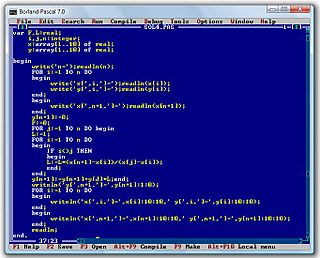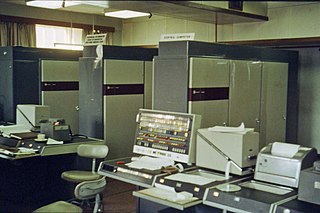
ALGOL is a family of imperative computer programming languages originally developed in 1958. ALGOL heavily influenced many other languages and was the standard method for algorithm description used by the Association for Computing Machinery (ACM) in textbooks and academic sources until object-oriented languages came around, for more than thirty years.

A computer program is a collection of instructions that can be executed by a computer to perform a specific task. Most computer devices require programs to function properly.
CORAL is a programming language originally developed in 1964 at the Royal Radar Establishment (RRE), Malvern, Worcestershire, United Kingdom (UK). It was influenced by ALGOL and JOVIAL, but is not a subset of either. Coral 66 was subsequently developed by I. F. Currie and M. Griffiths under the auspices of the Inter-Establishment Committee for Computer Applications (IECCA). Its official definition, edited by Woodward, Wetherall, and Gorman, was first published in 1970.

Niklaus Emil Wirth is a Swiss computer scientist. He has designed several programming languages, including Pascal, and pioneered several classic topics in software engineering. In 1984 he won the Turing Award, generally recognized as the highest distinction in computer science, for developing a sequence of innovative computer languages.

Pascal is an imperative and procedural programming language, designed by Niklaus Wirth as a small, efficient language intended to encourage good programming practices using structured programming and data structuring. It is named in honour of the French mathematician, philosopher and physicist Blaise Pascal.
In computer science, a high-level programming language is a programming language with strong abstraction from the details of the computer. In contrast to low-level programming languages, it may use natural language elements, be easier to use, or may automate significant areas of computing systems, making the process of developing a program simpler and more understandable than when using a lower-level language. The amount of abstraction provided defines how "high-level" a programming language is.
The Burroughs Large Systems Group designed large mainframes using stack machine instruction sets with dense syllables and 48-bit data words. The first such design is the B5000 in 1961. It was optimized for running ALGOL 60 extremely well, using simple compilers. It evolved into the B5500. Subsequent major redesigns include the B6500/B6700 line and its successors, and the separate B8500 line.
A system programming language is a programming language used for system programming; such languages are designed for writing system software, which usually requires different development approaches when compared with application software. Edsger Dijkstra refers to these language as Machine Oriented High Order Languages, or mohol.
ALGOL 60 is a member of the ALGOL family of computer programming languages. It followed on from ALGOL 58 which had introduced code blocks and the begin and end pairs for delimiting them, representing a key advance in the rise of structured programming. ALGOL 60 was the first language implementing nested function definitions with lexical scope. It gave rise to many other programming languages, including CPL, Simula, BCPL, B, Pascal, and C. Practically every computer of the era had a systems programming language based on ALGOL 60 concepts.

ALGOL 68 is an imperative programming language that was conceived as a successor to the ALGOL 60 programming language, designed with the goal of a much wider scope of application and more rigorously defined syntax and semantics.

Roger D. Moore was the 1973 recipient of the Grace Murray Hopper Award from the Association for Computing Machinery (ACM). It was given: "For their work in the design and implementation of APL\360, setting new standards in simplicity, efficiency, reliability and response time for interactive systems."
The history of programming languages spans from documentation of early mechanical computers to modern tools for software development. Early programming languages were highly specialized, relying on mathematical notation and similarly obscure syntax. Throughout the 20th century, research in compiler theory led to the creation of high-level programming languages, which use a more accessible syntax to communicate instructions.
ALGOL 58, originally named IAL, is one of the family of ALGOL computer programming languages. It was an early compromise design soon superseded by ALGOL 60. According to John Backus
"The Zurich ACM-GAMM Conference had two principal motives in proposing the IAL: (a) To provide a means of communicating numerical methods and other procedures between people, and (b) To provide a means of realizing a stated process on a variety of machines..."
The Whetstone benchmark is a synthetic benchmark for evaluating the performance of computers. It was first written in Algol 60 in 1972 at TSU. It was derived from statistics on program behaviour gathered on the KDF9 computer at NPL National Physical Laboratory in the United Kingdom, using a modified version of its Whetstone ALGOL 60 compiler. The workload on the machine was represented as a set of frequencies of execution of the 124 instructions of the Whetstone Code. The Whetstone Compiler was built at the Atomic Power Division of the English Electric Company in Whetstone, Leicestershire, England, hence its name. Dr. B.A. Wichman at NPL produced a set of 42 simple ALGOL 60 statements, which in a suitable combination matched the execution statistics.
KDF9 was an early British computer designed and built by English Electric. The first machine came into service in 1964 and the last of 29 machines was decommissioned in 1980 at the National Physical Laboratory. The KDF9 was designed for, and used almost entirely in, the mathematical and scientific processing fields – in 1967, nine were in use in UK universities and technical colleges. The KDF8, developed in parallel, was aimed at commercial processing workloads.
Brian Randell is a British computer scientist, and Emeritus Professor at the School of Computing, Newcastle University, UK. He specialises in research into software fault tolerance and dependability, and is a noted authority on the early pre-1950 history of computers.
The following outline is provided as an overview of and topical guide to computer programming:

The Atlas Computer was one of the world's first supercomputers, in use from 1962 until 1971. It was considered to be the most powerful computer in the world at that time. Atlas' capacity promoted the saying that when it went offline, half of the United Kingdom's computer capacity was lost. It is notable for being the first machine with virtual memory using paging techniques; this approach quickly spread, and is now ubiquitous.
In computing, a compiler is a computer program that transforms source code written in a programming language or computer language, into another computer language. The most common reason for transforming source code is to create an executable program.

The history of computing in the Soviet Union began during the late 1940s, when the country began to develop MESM at the Kiev Institute of Electrotechnology in Feofaniya. Initial ideological opposition to cybernetics in the Soviet Union in general was overcome during the Khrushchev era, and computer production was officially encouraged.